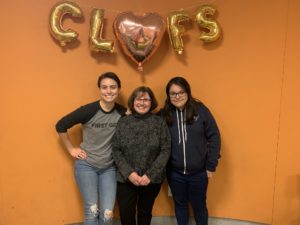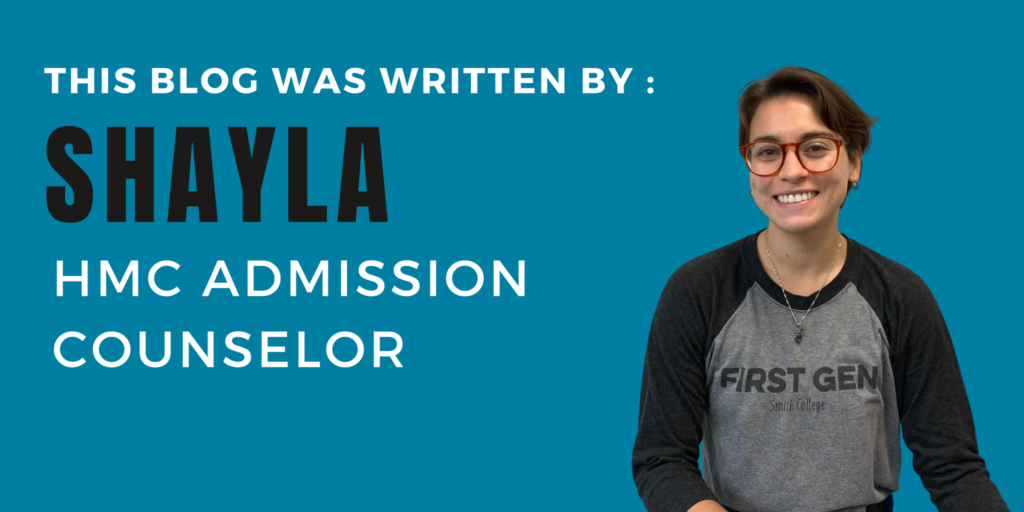Tip of the Month: If the School Fits!
November 3, 2021
Let me take you back to Fall 2015. A young Shayla is applying to college! She is the first in her family to do so and most of the time, she feels totally lost. Shayla decides to apply to 5 colleges: 1 state university, 1 two-year college, and 3 small liberal arts colleges. After much deliberation, she decides to attend a small school in Massachusetts. This school offers her many great things, including a lovely financial aid package (read more about Financial Aid in last month’s tip). Ultimately, Shayla’s choice was influenced by the college’s financial “fit.”

Flash forward to now! Shayla works as an Admission Counselor at Harvey Mudd! Hold on… this story is about ME!
As a first generation college graduate now working in higher education, I have learned so much about how and what goes into selecting a college. November 8th is National First Generation College Celebration Day – in recognition of all of the first generation students going through the college application process right now, I wanted to focus in on something that was totally new to me: the concept of “FIT.”
Here is what you need to know:
A good college for you will meet (or fit) your academic, social, environmental, and financial needs. This might be a little far fetched, but you can think of this in the terms of buying a new shirt:
- Academic Fit:
- Do I like the material this shirt is made of? Do I know other people who own this shirt? Do they like it? Can I ask them about it? Can I see myself keeping this shirt for a while (like 4 years)?
- Social Fit:
- Does it physically feel comfortable? Is the material breathable? Does it stretch or feel stiff against my skin? Can I try it on? Can I see myself in this shirt?
- Financial Fit:
- Lastly, can I afford this shirt? Is it more than I would typically pay for a shirt? Does that have benefits? Does that store have a payment plan or discount rates?
On the other side of this, Admission Offices at Liberal Arts Colleges are also seeking students who are a good fit for their institutional mission.
HMC practices something called “Holistic Application Review.” This means that in our selection process, we take into consideration an applicants’ experiences, activities, passions, and academic history. Additionally, we consider how the applicant might contribute to our college community as it aligns with the mission. Basically, we want to select students who will succeed academically and socially — and be happy at our school.
Consider fit from both perspectives: the applicant and the college.
Academic Fit
- Can the applicant do the work, will they thrive in a classroom environment?
To answer these questions, Admission Counselors look at the High School transcript, the rigor of the courses, test scores (keep in mind colleges have different testing policies – HMC is test optional). Remember, we are looking at more than just the numbers. We also look at letters of recommendation from teachers and counselors, as well as the context behind these components. Again, Academic Fit is only one piece of the puzzle.
Social Fit
- How does the student engage with their community? How might this transfer to our community?
Admission Counselors might look at how an applicant spends their time out of the classroom, the type of activities they are involved in and the subject of their essay. When filling out the application, make sure you account for the activities that take up your time. This can include jobs, clubs, even family responsibilities (like if you take care of siblings after school). Colleges want to hear your story. Another great way to figure out social “fit,” is by getting in contact with the Admission Office. Counselors are happy to answer questions and can connect you with current students who might be able to give you more insight.
Financial Fit
- How can we make college as affordable as possible?

We strongly encourage you to fill out the FAFSA and The CSS profile! Sometimes the price of college looks steep, however filling out these aid applications can make a huge difference financially. Harvey Mudd College is need blind, meaning we do not consider an applicants financial situation upon deciding admission. Moreover, we meet 100% of demonstrated need for U.S. Citizens and Permanent Residents (here’s more about Financial Aid).
Just as colleges do a holistic review, you can do this too! Consider how and where you “fit” as you begin to solidify your prospects. I hope Mudd makes the cut!
In my college search, I looked at state schools, liberal arts colleges, and junior colleges too. For me, it made more sense financially to attend a small liberal arts school because the aid I received from the school (combined with federal aid) was more than I would receive from my state university. I was happy with where I ended up going to school! While the transition to a college in the North East was challenging (by means of culture, the weather, making friends), when I reflect on my experience, the school I picked met my social, academic, and financial needs- even if I didn’t have the language to describe it at the time.
